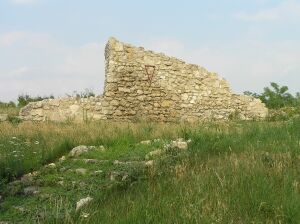Kutyavár (Dog Castle)
Translated by Dóra Lukács
If we turn from Balatoni Road to Kutyavári Road, we can find the oldest architectural monument in Érd, the ruins of a hunting lodge called Dog Castle. It was first mentioned in a charter in 1417. István Torma archeoligist researched the origins of the Dog Castle in Érd. He identified the remains of the buildings with the castellum of Diósd from the Middle Ages. “The castle mentioned as ‘of Diód’ in the other charters must have stood close to Diód, the Dog Castle, however, is situated quite far, almost 2 kilometres from the village founded again in the 18th century. According to the 18th-century borders, Diód in the Middle Age was located more to the West from its modern location.”
It was first mentioned in a charter in 1417. “The castellum of Diósd turns up in charters between 1417 and 1461. In 1417, István Cséri Sáfár’s grandchildren pawned their Castle in Diósd to János Fedémesi’s son, Miklós, and then they sold it to their relative, András Csapy’s wife, who became the owner in 1422. It was last mentioned in 1461, when László Setétkuti, the owner after András Csapy and his wife, died childless, and the king gave the property to Imre Hédervári.”
The rectangular castle was most likely already standing in the 14th century in a field called Stone Garden in the village of Diósd.
On the 13th of April, 1627, Mihály Tholdalagi, ambassador of Transylvania wrote this about Dog Castle: “13th April, on Tuesday I went to hunt from Buda Castle with the Chief Pasha and the Mufti Effendi. We saw lots of stags and deer, but it was hard to catch deer or rabbits. We came back to the khan of Hamza Bey, near where the old Hungarian kings raised hounds in a rectangular stone castle, which the Turks call Köpekhiszár (Dog Castle), we lodged next to a nice brook.”
Fülöp Batthyány had Ferenc Wajthay architect make the topographic map of the manor of Érd in 1864. The forester’s lodge, built in the yard created by the 7 metres high walls of Dog Castle, is visible on Wajthay’s drawing. The hunting lodge, which had 3 rooms heated with tile stoves, a kitchen with a free-standing chimney and a stove, a pantry and a stable, was built using one wall of the castellum around 1840. The shed stood in the corner of the castle walls at the end of the yard. Under the forester’s lodge there was a vaulted cellar; the roof was covered with reed.
The first part of József Érdy’s report from 1864 refers to this lodge among the ruined walls: “Dog Castle, a hunting lodge at the edge of the Forest, with romantic landscapes, where the remains of an old building are still visible. Prince Fülöp Batthyány was the lord about 25-30 years ago, who repaired and extended this hunting lodge, including the remains of the walls into the fences. The name Dog Castle originates from the fact that the Great Hungarian King, Matthias kept his hounds here, about 2 miles from Buda, and it is said that if he was in the mood for a hunt, he would stay here.”
Stones from the Roman Age were found next to Dog Castle, about which Floris Romer made these notes in 1864: “There are lots of bricks at the spring, but we found big, clumsy carvings from the Roman Age on the bank of the lake; some of these are now in the Stone Collection of the National Museum. One of them depicts Juno and Jupiter with the peacock and the eagle.”
Gyula Kereskényi, parish priest and the first local historian of Érd wrote: “Matthias kept his hounds in Dog Castle (a forester’s lodge at present), which is a quarter of an hour away from Érd and the walls of which are still standing; there was a great lake next to the building, which was surrounded with a fence, still standing today and used to keep game. Matthias, to escape his worries about the country, often made trips and entertained his guests here.” The lords later still undoubtedly used it as a hunting castle and forester’s lodge.
The final demolition of the hunting castle came with the parcelling and eradication of the forest.
In 1936 a national flag was built next to the ruined walls, and at the same time it became the centre of the festivities of the recreational area near Diósd. The stones were carried off after the Second World War, and only an insignificant piece of the walls remains today. However, the parts under the ground remained unchanged, so the archaeologists of the future will surely have more to say about this monument.
